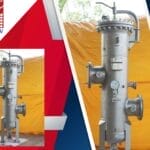What Is Gas Processing and What Are the Stages Involved in Gas Processing?
Gas processing is a set of techniques and equipment used to purify and separate raw natural gas extracted from underground reservoirs. The process involves removing impurities, such as water, carbon dioxide, sulfur compounds, and other contaminants so that the end result meets the quality standards and market specifications.
Gas processing involves a series of operations aimed at converting raw natural gas from its original state to a marketable product. It is a crucial step in the energy industry, ensuring that natural gas is purified, conditioned, and transported efficiently. We have listed the different stages that are involved:
- Inlet Reception and Pre-Treatment ensure the removal of large particles, such as sand and debris from raw natural gas that enters the processing facility
- The gas then undergoes various separation techniques that include centrifugal separation and gravity separation
- In order to prevent corrosion in equipment and pipelines, the gas stream goes through the process of dehydration
- For efficient transportation, natural gas is compressed to pipeline pressure
What Is the Need for Filtration in Gas Processing?
Filtration plays a pivotal role in gas processing, addressing the diverse challenges presented by raw natural gas streams. The need for filtration arises from the presence of contaminants and impurities that can degrade the quality of the gas and compromise the efficiency and integrity of processing equipment and transportation infrastructure. Contaminants such as liquid droplets, solid particles, moisture, and corrosive compounds must be removed to meet stringent quality standards, ensure safe operations, and protect downstream equipment from fouling and damage. Filtration not only enhances the purity of natural gas but also safeguards critical components such as compressors, pipelines, and heat exchangers against erosion, corrosion, and premature wear. By effectively capturing and removing unwanted substances, filtration systems contribute to the reliability, longevity, and sustainability of gas processing operations, facilitating the production of cleaner, more marketable gas products for various industrial and commercial applications.
What Is the Role of Fuel Gas Coalescer in the Filtration Process?
The role of a fuel gas coalescer in the filtration process is to effectively remove liquid droplets from the fuel gas stream. In many gas processing operations, fuel gas is utilized for various purposes such as combustion in turbines, boilers, and heaters. However, fuel gas often contains small liquid droplets, which can cause issues such as equipment fouling, reduced combustion efficiency, and increased maintenance costs.
A fuel gas coalescer works by employing the principle of coalescence, which involves merging smaller liquid droplets into larger ones to facilitate their separation from the gas stream. The coalescer typically consists of a series of coalescing elements, such as fibrous materials or mesh pads, arranged in a housing. As the gas stream passes through the coalescer, the liquid droplets suspended in the gas come into contact with the coalescing elements. Due to the design of these elements, the liquid droplets coalesce or combine with each other, forming larger droplets.
Once the droplets reach a sufficient size, gravity or other separation mechanisms cause them to settle out of the gas stream and collect at the bottom of the coalescer housing. The purified gas then exits the coalescer, ready for further processing or use as fuel.
How Does Coalescer Filter Work?
Coalescer filters operate based on the principle of coalescence, which involves the merging of smaller liquid droplets into larger ones. These larger droplets are then easier to separate from the gas stream. Here is a step-wise process of the function:
- Coalescer filters typically consist of specialized filter media, such as fibrous materials or mesh pads that are arranged within a housing. The filter media provides a surface for liquid droplets suspended in the gas stream to collect and coalesce.
- As the gas stream passes through the filter media, the smaller liquid droplets present in the gas come into contact with the fibers or surfaces of the filter media. Due to the momentum of the gas flow and the surface tension of the liquid, the droplets adhere to the filter media.
- Once the liquid droplets adhere to the filter media, they begin to coalesce or merge with each other. This process occurs as a result of the droplets colliding and combining, forming larger droplets. The fibers or surfaces of the filter media facilitate this coalescence by providing a physical barrier and promoting contact between droplets.
- As coalescence continues, the size of the liquid droplets increases. The combined droplets grow in size, becoming larger and heavier as they accumulate more liquid from the gas stream.
- Eventually, the coalesced droplets become large enough that gravity overcomes the forces keeping them suspended in the gas stream. The larger droplets separate from the gas phase and settle downward due to gravity, collecting at the bottom of the coalescer housing.
- The separated liquid collects in a sump or drainage area at the bottom of the coalescer housing. From there, it can be drained or removed from the system through a drain valve or other means.
Sungov Engineering employs advanced coalescing technology, with the help of specially designed multi-layered filter elements to attain exceptional separation efficiencies. These elements are meticulously crafted in Sungov’s own clean room facility. Remarkably efficient, Sungov’s filter elements are engineered to effectively separate even the finest lube oil aerosols within the submicron range, which may become entrained downstream in gas compressor operations.
How Can Proper Sizing and Placement of Gas Coalescing Filter Separator Optimize Performance?
By carefully considering the sizing and placement of coalescer filters in gas processing systems, operators can optimize their performance, enhance liquid removal efficiency, minimize maintenance requirements, and ensure the integrity of downstream equipment and processes.
Coalescer filters must be sized appropriately to accommodate the flow rate of the gas stream. Undersized filters may result in insufficient residence time for effective coalescence, leading to reduced separation efficiency. Oversized filters, on the other hand, may incur unnecessary costs and occupy excessive space without providing additional benefits. Proper sizing also ensures that the coalescer filter elements have sufficient surface area and capacity to capture and coalesce liquid droplets of various sizes present in the gas stream. This helps maintain high retention efficiency and prevent carryover of liquid contaminants downstream.
Fuel gas coalescers should be strategically placed in the gas processing system to maximize their effectiveness. Placing the filters upstream of sensitive equipment, such as compressors, turbines, or downstream processing units, helps protect these components from liquid contamination and potential damage. Coalescer filters should be installed in locations where flow disturbances, such as turbulence or sudden changes in flow direction, are minimized. Turbulent flow conditions can disrupt the coalescence process and hinder the efficient separation of liquid droplets.
As industries continue to rely on natural gas as a clean and versatile energy source, the importance of coalescer filters in gas processing remains paramount, driving innovation and advancement in filtration technology to meet evolving industry demands. By employing advanced coalescing technology and proper sizing and placement strategies, operators can optimize the performance of coalescer filters, achieving high separation efficiencies and maintaining the integrity of gas processing systems.




